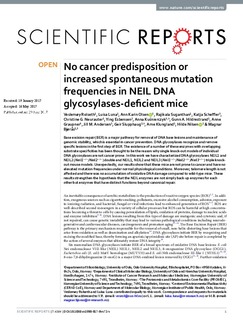| dc.contributor.author | Rolseth, Veslemøy | |
| dc.contributor.author | Luna, Luisa | |
| dc.contributor.author | Olsen, Ann-Karin | |
| dc.contributor.author | Suganthan, Rajikala | |
| dc.contributor.author | Scheffler, Katja | |
| dc.contributor.author | Neurauter, Christine Gran | |
| dc.contributor.author | Esbensen, Qin Ying | |
| dc.contributor.author | Kusnierczyk, Anna | |
| dc.contributor.author | Hildrestrand, Gunn Annette | |
| dc.contributor.author | Graupner, Anne | |
| dc.contributor.author | Andersen, Jill Mari | |
| dc.contributor.author | Slupphaug, Geir | |
| dc.contributor.author | Klungland, Arne | |
| dc.contributor.author | Nilsen, Hilde | |
| dc.contributor.author | Bjørås, Magnar | |
| dc.date.accessioned | 2017-08-16T07:53:25Z | |
| dc.date.available | 2017-08-16T07:53:25Z | |
| dc.date.created | 2017-08-15T10:45:37Z | |
| dc.date.issued | 2017 | |
| dc.identifier.citation | Scientific Reports. 2017, 7 . | nb_NO |
| dc.identifier.issn | 2045-2322 | |
| dc.identifier.uri | http://hdl.handle.net/11250/2450839 | |
| dc.description.abstract | Base excision repair (BER) is a major pathway for removal of DNA base lesions and maintenance of genomic stability, which is essential in cancer prevention. DNA glycosylases recognize and remove specific lesions in the first step of BER. The existence of a number of these enzymes with overlapping substrate specificities has been thought to be the reason why single knock-out models of individual DNA glycosylases are not cancer prone. In this work we have characterized DNA glycosylases NEIL1 and NEIL2 (Neil1−/−/Neil2−/−) double and NEIL1, NEIL2 and NEIL3 (Neil1−/−/Neil2−/−/Neil3−/−) triple knock-out mouse models. Unexpectedly, our results show that these mice are not prone to cancer and have no elevated mutation frequencies under normal physiological conditions. Moreover, telomere length is not affected and there was no accumulation of oxidative DNA damage compared to wild-type mice. These results strengthen the hypothesis that the NEIL enzymes are not simply back-up enzymes for each other but enzymes that have distinct functions beyond canonical repair. | nb_NO |
| dc.language.iso | eng | nb_NO |
| dc.publisher | Nature Publishing Group | nb_NO |
| dc.relation.uri | http://www.nature.com/articles/s41598-017-04472-4.pdf | |
| dc.rights | Navngivelse 4.0 Internasjonal | * |
| dc.rights.uri | http://creativecommons.org/licenses/by/4.0/deed.no | * |
| dc.title | No cancer predisposition or increased spontaneous mutation frequencies in NEIL DNA glycosylases-deficient mice | nb_NO |
| dc.type | Journal article | nb_NO |
| dc.type | Peer reviewed | nb_NO |
| dc.description.version | publishedVersion | nb_NO |
| dc.source.pagenumber | 12 | nb_NO |
| dc.source.volume | 7 | nb_NO |
| dc.source.journal | Scientific Reports | nb_NO |
| dc.identifier.doi | 10.1038/s41598-017-04472-4 | |
| dc.identifier.cristin | 1486273 | |
| dc.description.localcode | This article is licensed under a Creative Commons Attribution 4.0 International License, which permits use, sharing, adaptation, distribution and reproduction in any medium or format, as long as you give appropriate credit to the original author(s) and the source, provide a link to the Creative Commons license, and indicate if changes were made. The images or other third party material in this article are included in the article’s Creative Commons license, unless indicated otherwise in a credit line to the material. If material is not included in the article’s Creative Commons license and your intended use is not permitted by statutory regulation or exceeds the permitted use, you will need to obtain permission directly from the copyright holder. To view a copy of this license, visit http://creativecommons.org/licenses/by/4.0/. | nb_NO |
| cristin.unitcode | 194,65,15,0 | |
| cristin.unitname | Institutt for kreftforskning og molekylær medisin | |
| cristin.ispublished | true | |
| cristin.fulltext | original | |
| cristin.qualitycode | 1 | |

